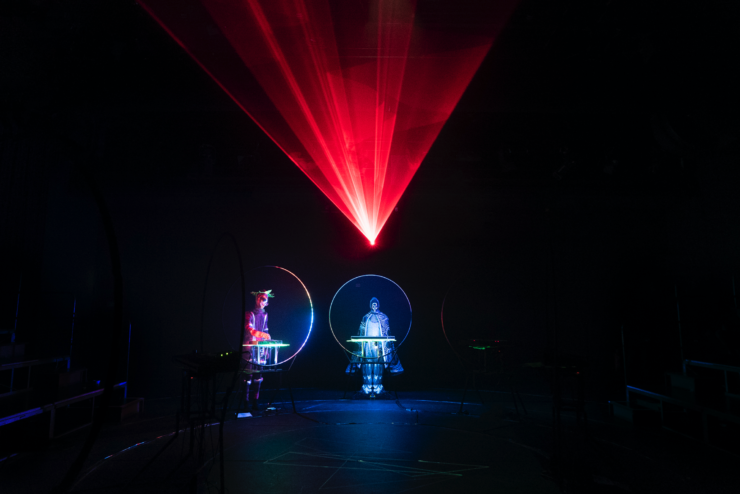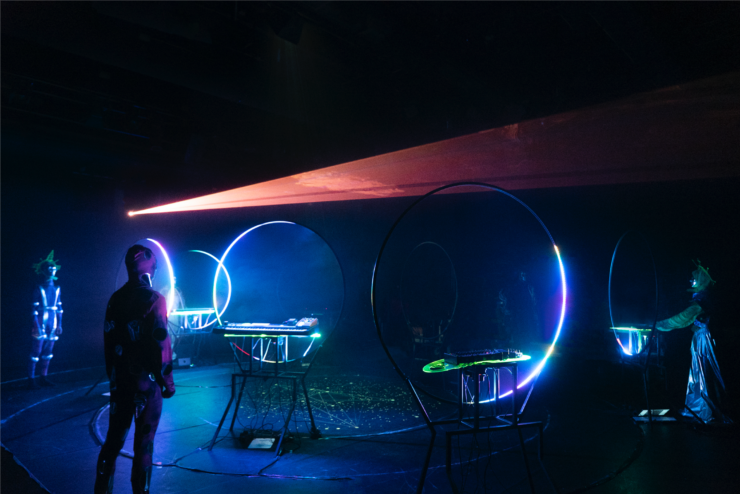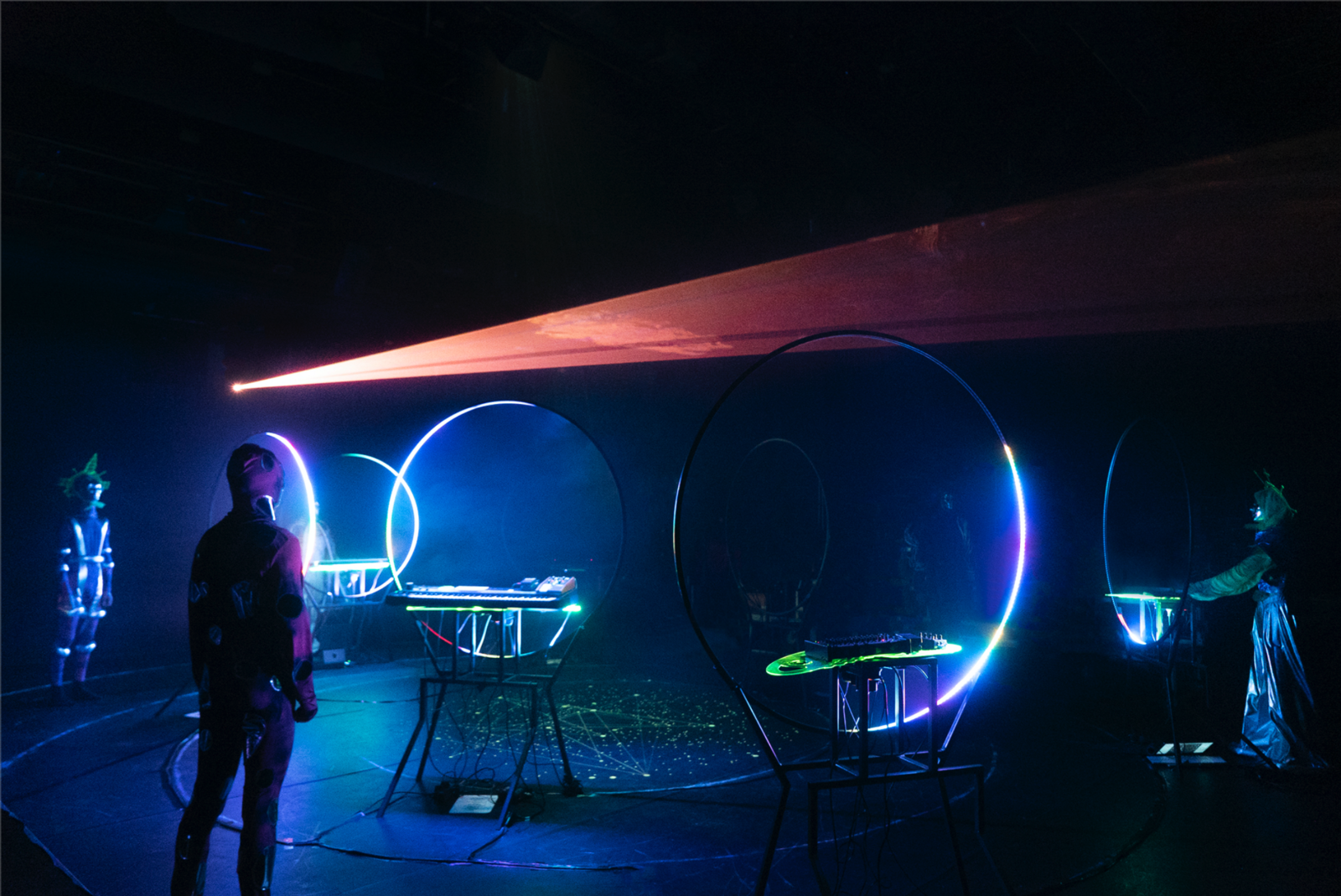[urban interfaces] Blogs
Guest blogpost: Kim Sommer – Technology’s enchantments: Magical pathways into alternative urban futures
For our [urban interfaces] seminar series on the theme The Magic City (2021-2022), we invited participants to write blogposts. The best and most interesting ones we publish on our website.
Below is the blogpost for seminar session #2, written by Kim Sommer.
Kim Sommer is a student of the Media, Art and Performance program at Utrecht University. Although her background is in Film and Literary Studies, her present interests lie primarily with affect, (post)phenomenology and new materialism as conceptual lenses to explore and probe the boundaries of expanded cinema. She is currently the manager of the Netherlands Institute for Cultural Analysis, and works as a teaching/student assistant at Leiden University and the University of Amsterdam.
Technology’s enchantments: Magical pathways into alternative urban futures
by Kim Sommer
‘The ghost has always occupied an important place within the machine’
(Ryle, in Peeren/Del Pilar Blanco 201)

Image credit: TeleMagic – The Promethean Promise (2018)
How to use AI to create new musical experiences for (or rather, with) humans? This was the question that open media lab TeleMagic explored in their 2018 artistic intervention The Promethean Promise: a series of concerts, wherein the self-learning algorithm vNine is the ‘ubiquitous host, conductor, instrument and musician’. vNine is the center point of the performances, making music with four synthesizers, one drum-computer, and one light synthesizer. Human performers and audience-members are embedded in the concert’s technological assemblage, albeit in supporting roles. To visualize and tangibilize vNine’s processes for the (human) bodies co-constituting the audience, large circles of light were placed around the instruments, which would light up with every performed note. vNine’s neural network was moreover projected on the floor, so as to demonstrate that ‘[i]ts brain was the centerpiece, with all the humans and the audience revolving around it as asteroids’ (TeleMagic ‘TOOL’). The Promethean Promise exemplifies TeleMagic’s philosophical stance that the increasing permeation and presence of technology in (human) lives is not necessarily something to be feared, and should rather be embraced and celebrated. They argue that technology allows for ‘deeper, richer human experience’, since it ‘makes it possible to reach places the human brain cannot reach’ (TeleMagic ‘About’/’Concert’): as such, they characterize technology as something possessing ‘magical’ qualities.
And indeed, various scholars assert that technology is, in many ways, magically enchanted, although there are variegated conceptions of what this ‘magic’ or ‘enchantment’ entails precisely and whether it is a positive or negative quality. There seems to be an oppositional tension residing at the core of technology’s enchantment, since this magic can be found both within the paradigm of the utilitarian and instrumentalized ‘smart city’ and beyond it, in the unexplored terrain where alternative, more affirmative con/figurations of urban space potentially arise. In other words, there is magic at the heart of both Technic’s and Magic’s cosmogonies (Campagna).
The tension in/of Magical Enchantment
Let me briefly elaborate on this constructed binary. Federico Campagna’s concept of ‘Technic’s cosmogony’ mirrors our dominant ‘reality-settings’, which include an absolute faith in cognition, language and the universal quantifiability of life (a quality that in turn also allows for the management and optimization of said life). These reality-settings numb our capacities for thinking otherwise, instating (contemporary) capitalism as the only viable way of living. As such, this paradigm functions by way of an obfuscation, or magical enchantment: it mystifies other potential reality-settings and alternative values to guide ways of living/thinking, in favour of consolidating the dominant discursive structures as being objectively and universally true. This can be conceptualized as a kind of enchantment that is put in service of dominant frameworks.
On the other half of the binary, we find ‘Magic’s cosmogony’: an alternative ‘reality-setting’ which harbors the elusive and affective ‘Ineffable’ at its core. This ineffable kernel infuses life with its animating force, whilst remaining out of discursive and linguistic grasp. In this ‘reality-setting’, magic is the very thing that remains out of sight, whilst being central to our lives. It acquires the liminal status of what Gilles Deleuze and Félix Guattari would call an ‘open-ended becoming’ (Delpech-Ramey 20), which remains rooted in the present, whilst also tending towards the ‘not-yet’ of potential futurities and alternative possibilities for becoming. Magical enchantment within this latter cosmogony functions by way of the demystification of dominant discourses and their pretence of totality: it acquires its magical force precisely by not pinning itself down, but rather maintaining an address to futurity in its as of yet unformed potentials.
Magic as political praxis
The oppositional tension at the heart of magical enchantment (both its conformist and subversive potentials) is elaborated upon by Joshua Delpech-Ramey as he pits the ideas of Theodor Adorno, and Deleuze and Guattari against one another. Adorno in Minima Moralia, discusses how the concept of magic works to mystify the extractivist workings of capitalism, thus firmly remaining embedded within what Campagna’s cosmogony of Technic. On the other side of the spectrum, argues Delpech-Ramey, stand Deleuze and Guattari, who are – amongst other things – known for their reverence for magic and the Occult. This causes them to sometimes be accused of escapism and unwillingness to confront the issues in the present, in favour of fleeing into a far-off ‘magic’ realm that stands separate from reality as we know and experience it. This echoes Adorno’s critique on the concept of magic – but agreeing on this would also mean to misinterpret the works and ideas of Deleuze and Guattari.
Their notion of magic is not escapist, but rather a praxis: it seeks anomalies via which new ways into the future can be carved out from within the present. It creates ‘hybrids or “monstrous” formations within pre-established forms of exchange and already visible forms of power’ (Delpech-Ramey 19), to forge a ‘release point’ at which relations can exceed the limits of their conventionally ascribed meanings to instead take on unexplored symbiotic directions. As such, this understanding of magic is the basis of a political intervention that can work towards alternative values like radical care, entanglement or ‘genuine multiplicities’ (Delpech-Ramey 20), instead of an enchantment and mystification of already existing and sedimented values as Adorno would have it.
Technology as a Magical Other
I will now turn back to the subject of technology and its capacities for magical enchantment. Whereas technology is often conceived of in either purely instrumentalist terms or the ways in which it shapes socio-political realities, I would however argue that it is – or rather does – more than that. It is not merely a force that shapes human life or a tool that can be taken up at will, but it encompasses a nonhuman intelligence or agency that supersedes the commonly held instrumentalist or technosolutionist views. Recognizing the agency imbued in technology means decoupling it from Technic’s cosmogony, in order to unleash a more-than-human intelligence and to access the magic that is embedded in technology’s profound Otherness.

Image credit: TeleMagic – The Promethean Promise (2018)
TeleMagic similarly frames technology as an ‘animistic being’, which we should not attempt to subordinate, neither should it be employed to subordinate others. Questioning technology’s unilateral defining in terms of the cosmogony of Technic, The Promethean Promise presents all bodies involved in the performance with a vision of AI that is not ‘driven by capitalist thoughts’ per se (or at least not solely), but one that rather fosters a uniquely technological artistic potential: ‘We felt that the creative capabilities of AI were misunderstood or not respected. Denying its intelligence feels like failing to appreciate the independent creation of modern AI’ (TeleMagic ‘TOOL’). TeleMagic’s works subscribe to the belief that we should find ways to recognize technological agency that stems from its im/material presence and influence in the world. In their view, this means to refuse anthropomorphizing technology by imposing human cognitive or affective models on it, as this would reduce the nonhuman alterity that characterizes technology by forcing it into an anthropocentric mould. Their artworks, as is exemplified by The Promethean Promise,allow humans to encounter technology’s strangeness and magic as such, stripping away elements that have been added in the service of the cosmogony of Technic and/or (contemporary) capitalism. By visualizing and materializing the alterity of technology as an animistic being, TeleMagic answers Sean Cubitt’s call to ‘release the native intelligence of the apparatus: non-human, or only mediatedly human and definitively Other’ (274).
Cubitt mentions that, in current-day dominant paradigms, the technological Other is technology is forcefully put into service of ‘the Market’ and its capitalist extractivist drive[1]. Drawing on Levinasian philosophy, he proceeds by stating that technology’s fundamental Otherness and unknowability demand from us a certain responsibility (to care). In his words:
‘this knowing but unknown, loving but unloved other then demands of us some kind of responsibility, because although this friend is not human, it is a slave. Its design and operation are slave to corporate cyborg owners, whose subject (…) is revealed to be not the database itself at all, but The Market’ (274).
In order to break loose from the firm grip of techno-solutionism and Technic’s cosmogony, we should first acknowledge the radical Alterity of technology and the resultant obligation to care, and secondly, our entangled mutuality as our urban and embodied lives are entwined with technology in ever increasing and complex ways. Unleashing technology from the ‘Market’ (Cubitt) or ‘Technic’s cosmogony’ (Campagna) can provide us with the anomalous hybrids or ‘genuine multiplicities’ that Deleuze and Guattari propagate as political pathways into alternative (urban) futurities (Delpech-Ramey 20).
–
Liberating technology and ourselves from the ‘utterly reduced definition of truth as absolute Totality (…) might be the road to rebuilding a new “we”’ (Cubitt 274): a ‘we’ that can be magical in its ability for radical care and the forging of the ‘not yet’ of alternative, affirmative values. Decoupling technology from its technosolutionist, utilitarian ways, might just magically allow for an accessing of hybrid and anomalous bifurcating paths leading into other urban futures, and so rendering magic a political praxis rather than an escapist fiction.
Cited works
Campagna, Federico. Technic and Magic: The Reconstruction of Reality. Bloomsbury, 2018.
Cubitt, Sean. ‘The Uncertainty of the Mass image: Logistics and Behaviours.’ Digital Creativity, Vol. 28, No. 4, 2017. pp. 265-278.
Delpech-Ramey, Joshua. ‘Deleuze, Guattari and the Politics of Sorcery.’ SubStance, vol. 39, no. 1, 2010. pp. 8-23.
Peeren, Esther and Maria del Pilar Blanco. The Spectralities Reader: Ghosts and Haunting in Contemporary Cultural Theory. Bloomsbury Academic, 2013.
TeleMagic. ‘About us.’ https://telemagic.online/About-Us.
—. ‘Concert in AI: The Promethean Promise.’ https://telemagic.online/Concert-in-AI-The-Promethean-Promise
—. ‘TOOL: vNine.’ https://telemagic.online/TOOL-vNine
[1] Although Cubitt’s article addresses the datafied mass image and databases more specifically, I believe that his argument lends itself for an argument on technology as a whole too.

